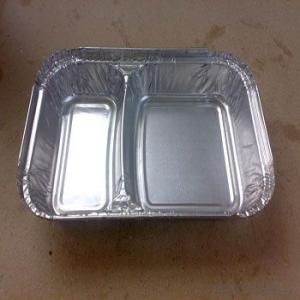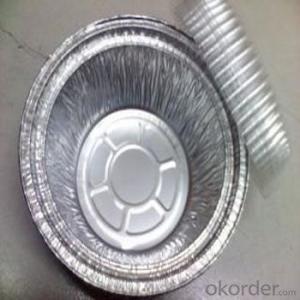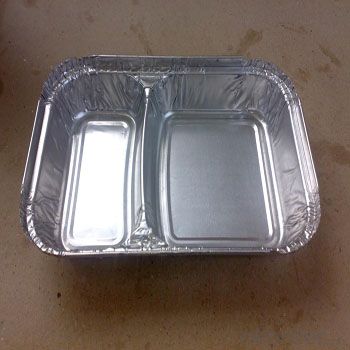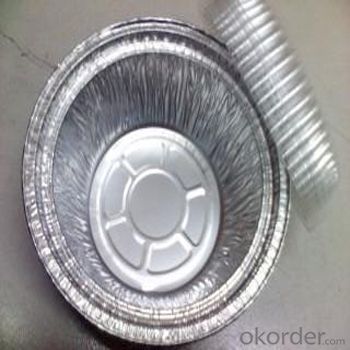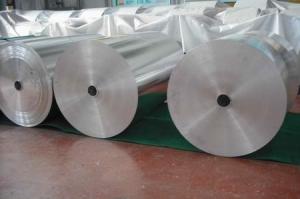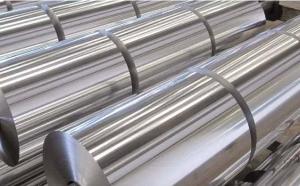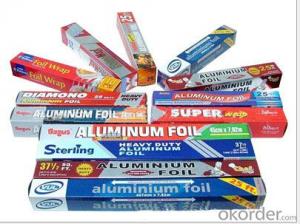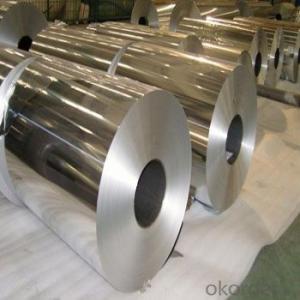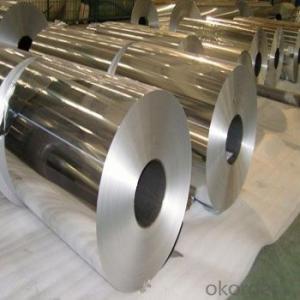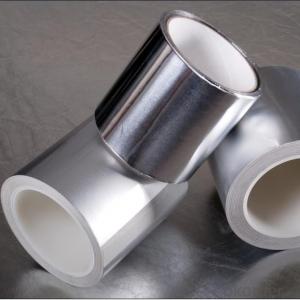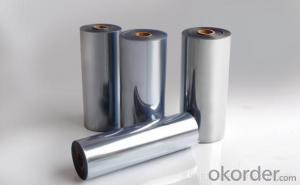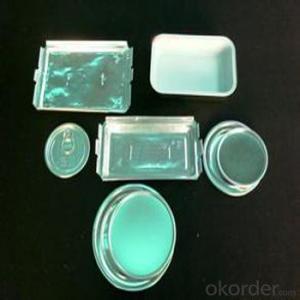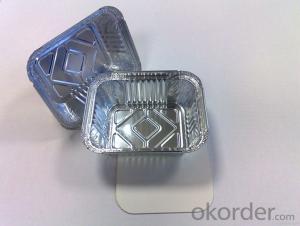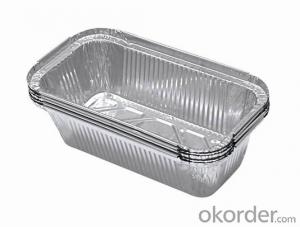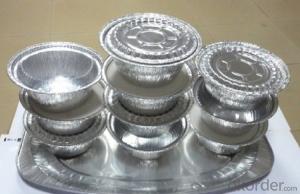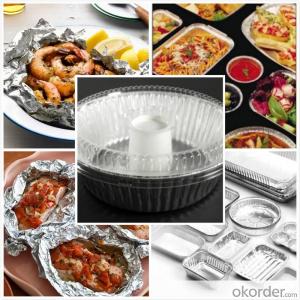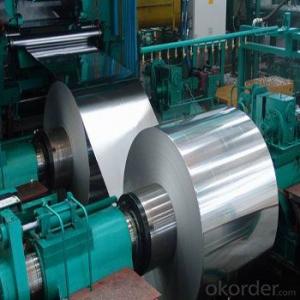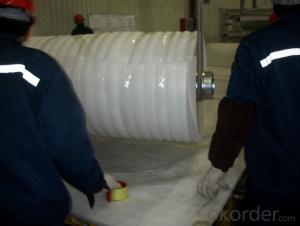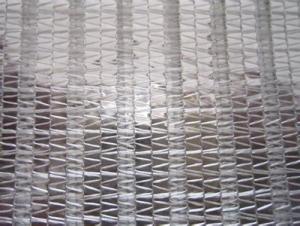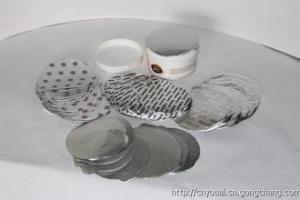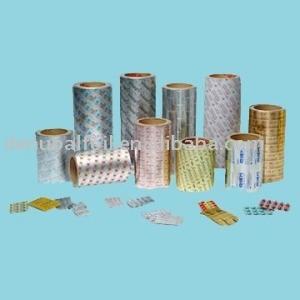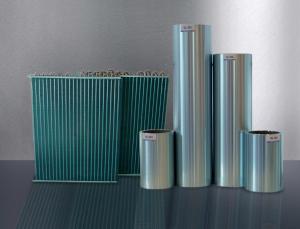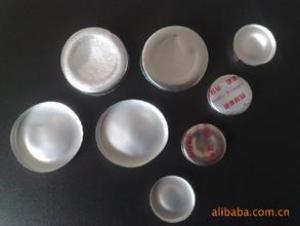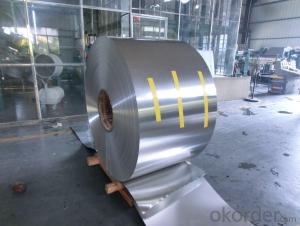Aluminum Foil Grill Bags for Different Food Containers
- Loading Port:
- Shanghai
- Payment Terms:
- TT or LC
- Min Order Qty:
- 3 m.t.
- Supply Capability:
- 100 m.t./month
OKorder Service Pledge
OKorder Financial Service
You Might Also Like
1.Specification
container foil
Appication: For different food container, such as dishes, plates, trays, etc
Alloy: 8011/3003
Temper:O/H22/H24
Thickness& Tolerance: 0.05mm-0.20m(±8%)
Width& tolerance: 200mm-1650mm(±1mm)
Mechanical Properties: Tensile Strength(U.T.S)≥49Mpa, Elongation≥1%
Standard: GB/T3198/ASTM-B209/EN546
2.History about aluminum
Before aluminium foil
Foil made from a thin leaf of tin was commercially available before its aluminium counterpart. Tin foil was marketed commercially from the late nineteenth into the early twentieth century. The term "tin foil" survives in the English language as a term for the newer aluminium foil. Tin foil is less malleable than aluminium foil and tends to give a slight tin taste to food wrapped in it. Tin foil has been supplanted by aluminium and other materials for wrapping food.
The first audio recordings on phonograph cylinders were made on tin foil.
Tin was first replaced by aluminium in 1910, when the first aluminium foil rolling plant, "Dr. Lauber, Neher & Cie." was opened in Emmishofen, Switzerland. The plant, owned by J.G. Neher & Sons, the aluminium manufacturers, started in 1886 in Schaffhausen, Switzerland, at the foot of the Rhine Falls, capturing the falls' energy to produce aluminium. Neher's sons, together with Dr. Lauber, discovered the endless rolling process and the use of aluminium foil as a protective barrier in December 1907.
In 1911, Bern-based Tobler began wrapping its chocolate bars in aluminium foil, including the unique triangular chocolate bar, Toblerone. By 1912, aluminium foil was being used by Maggi (today a Nestlé brand) to pack soups and stock cubes.
The first use of foil in the United States was in 1913 for wrapping Life Savers, candy bars, and gum. Processes evolved over time to include the use of print, colour, lacquer, laminate and the embossing of the aluminium.
3.Why you can choose us?
Our best quality, Best service!
4.Pictures
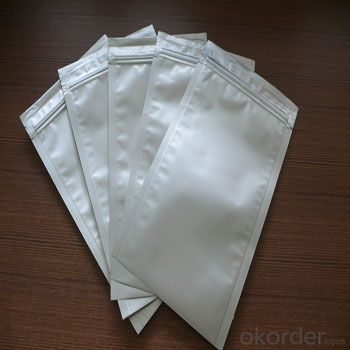
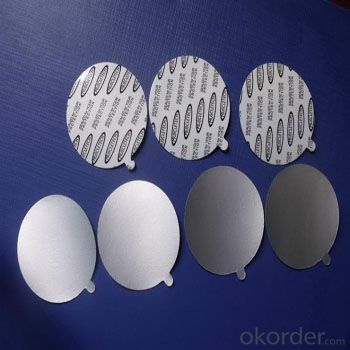
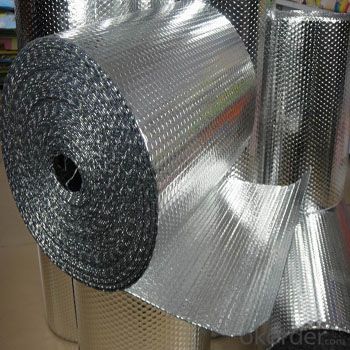
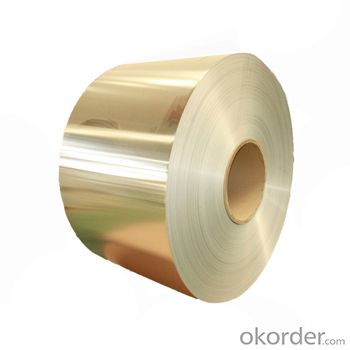
5.FAQ
1)Can we supply samples?
Yes, we can!
2)What can you do if you have other quastions?
You can contact us freely at any time!
3)How about our payment term?
LC and TT and other.
- Q: idea for science working model related to heat or water or light for 7th grader?
- HONDA all the way!!!!!
- Q: Explain thouralghy!!
- Being made in God's image has no longer something to do with the way we glanceGod isn't a guy hence God can not appear like a guyGod is a spiritSpirits do no longer choose air to stay aliveGod is a male yet no longer a guy because of the fact he isn't a individual (no guy has ever seen God at each time)A male lion can not be reported as a guy because of the fact he isn't a individualTo be made in God's image ability human beings have been created with capacity to worship whilst animals weren't.
- Q: I have just purchased 1000sqft of hardfloor and planning to install it todayWhen i opened the boxes, there are thin aluminum foil sticked on the back of my floor pieces.do i need to peel them off? or just leave them onThanks
- cover it good with aluminium until it soft .then remove ???????.heat it from up until it become crispy.
- Q: I buttered the pan and after I remove it from the oven it is stuck to the pan so what do I do? I didn't wait is 10 minutes long enough to let stand? Any tips ?
- 10 minutes should be long enoughI have never had good luck with silicone pansThe cakes tend to bake lighter than normal and appear under doneThat might be what occurred with yoursProblem is if you allow it to cool too long the butter solidifies to the pan again making the cake stickThe way around that is to heat it a gain for a little bit just to soften the butterYou might just have to run a thin blade of a knife around each grove in the pan to help release itIf you have to do that you can use fancy paper at the base to cover up any little goofs Or press aluminum foil to the pan getting all the groves then slip the cake into the foil so it will look like a large foil linerWhen you serve just peel back the foil and slice.
- Q: I realized I glued my artificial nail on the wrong way and i wanna take it off , but I don't want to rip it off because it'll hurtAny suggestions?
- This Site Might Help YouRE: PIIX3 or ICH9 chipset for virtual machine? I'm playing with Oracle virtual box and I'm just wondering which chipset I should use? What's the difference as far as performance?
- Q: Is it possible to use aluminum foil as a material for sandwich preparation?
- <p>Aluminum foil is not suitable for making sandwiches. It is not a food-grade material and does not provide the necessary flexibility or texture for sandwich preparation. Instead, use materials like bread, tortillas, or lettuce wraps that are designed for food and can safely hold ingredients together. Aluminum foil is typically used for cooking, storage, or wrapping food to keep it fresh, not for direct food preparation.</p>
- Q: Any good Vanilla Fudge resipies?
- Vanilla Fudge 500g caster sugar 2 x 170g cans evaporated milk 4 tbsp milk Pinch of salt 100g butter, cubed, plus extra for greasing 1 vanilla pod, split 1Line a 20cm-square cake tin or similarly sized loaf tin with silver foil, extending the foil over the edges of the tinGrease the foil and set aside 2Put the sugar, milk, evaporated milk, and salt into a large panPlace the pan over a low heat and stir gently until the sugar has dissolved, then increase the heat to medium and bring the mixture to the boil, without stirringOnce boiling, lower the heat and cook, stirring frequently to prevent the mixture sticking, for 30 minutes 3Remove the saucepan from heat and add the butter and vanilla pod but do not stirLet the mixture cool, without stirring, for about 15 minutes 4Remove the vanilla pod and beat vigorously with a wooden spoon until it becomes thick and just starts to lose its gloss (this should take about 10 minutes) 5Pour the fudge into the prepared tin, leave for about 30 minutes, then score into 2.5cm squares while still warmLeave until cold (it will remain quite soft-textured), then use the foil to lift the fudge out of the panCut into squaresStore in an airtight container in the fridge.
- Q: how to know primer is ready motorcycle fairing painting?
- My grandmother had a book of etiquette from the 20s or 30s and I kinda skimmed over a few chapters when I was a kidOne of the things that stuck in my mind was the reference to bathingThe book recommended taking a hot bath once a week, preferably on Saturday, so you would be clean and not smell offensive during Sunday church services.
- Q: I want to make a really nice lasagna but I'm really bad at making it.Can anyone give me some easy steps on how to make a cheese lasagna.And how long it takes to cook.I try to follow recipes, but it still doesn't come out right.Thankyou :)
- use McCormick's BBQ seasoning smoke 2.5-3.5 hr maintaining a temp of 225-250 deg I prefer cattleman's sauce, you don't have to depend on your taste.
- Q: I have an old aluminum trash can that I don't use any more and a bunch of papers I want to burn, so I am trying to figure out if it would be safe or not to start a fire in it? Obviously I would be doing this outdoors in my backyard with a fire extinguisher nearby.
- There's nothing dangerous about the aluminum trash canJust don't burn too many papers at onceIt's possible to melt the aluminum with too hot a fire[And to be fussy: You also should check to find out what the burning ordinances are where you live.]
Send your message to us
Aluminum Foil Grill Bags for Different Food Containers
- Loading Port:
- Shanghai
- Payment Terms:
- TT or LC
- Min Order Qty:
- 3 m.t.
- Supply Capability:
- 100 m.t./month
OKorder Service Pledge
OKorder Financial Service
Similar products
Hot products
Hot Searches
Related keywords
